Perilous rides: Indonesian authorities discourage overloaded bikes as millions travel home for Idul Fitri
CNA’s Nivell Rayda and Wisnu Agung Prasetyo rode a motorcycle on a 230km journey from Jakarta to Cirebon in West Java in a bid to experience the annual mudik exodus.
.jpg?itok=EGcbIut6)
People in Indonesia travelling to their home town ahead of the Idul Fitri holiday. (Photo: CNA/Wisnu Agung Prasetyo)
CIREBON, Indonesia: It was like my body was screaming for our motorcycle to stop. My buttock was in pain, my legs felt numb and I was struggling to stay awake despite the cool refreshing wind in my face.
We were only 50km into our 230km journey from Jakarta to Cirebon in West Java and already I was thinking: “Had I bitten off more than I can chew?”
Three hours before, I was determined to find out what it is like for Indonesians who leave major cities during the final days of the Muslim fasting month of Ramadan so they can spend Idul Fitri – one of the religion’s most important holidays – with their families in their respective hometowns and villages.
In particular, I wanted to know what the journey is like for the millions of Indonesians who decide to perform the annual exodus, known in Indonesia as “mudik”, on the back of motorcycles.
The government estimated that this year, 123 million Indonesians will perform mudik, the first Ramadan exodus since the authorities lifted virtually all restrictions to curb the spread of COVID-19 on Dec 31.
Of the figure, 25 million are expected to make the journey on two wheels, despite repeated attempts by the government to discourage the practice.
“A campaign to dissuade people from using motorcycles (during mudik) is needed. Please don’t use motorcycles because it is very dangerous,” Indonesian Transportation Minister Budi Karya Sumadi told a discussion in Jakarta on Apr 7.
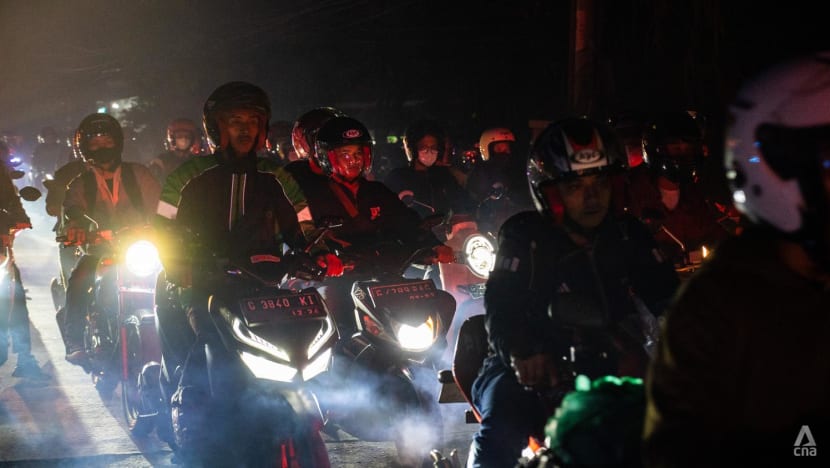
Lacking the stability, comfort and safety of a four-wheeler, motorcycles are a dangerous form of travel. In 2022, motorcycles contributed more than 65 per cent of the 94,000 accidents recorded across Indonesia, according to data from the Indonesian Traffic Police Corps.
The risk increases during the mudik season as motorcyclists sometimes haul oversized goods and carry more than one passenger on a single vehicle. Mudik-goers also tend to bring their young children along for the arduous journey, often without equipping them with helmets.
In a bid to persuade people to leave their motorcycles at home, the Indonesian government has been offering free ferries, trains and buses for those returning to their hometowns.
The Jakarta police has also opened its doors to mudik-goers looking to leave their motorcycles at the safety of its precincts.
But these efforts can only accommodate thousands of travellers instead of the millions who perform mudik on motorcycles each year.
DANGEROUS JOURNEY AS FATIGUE SETS IN
Unlike my visual journalist Wisnu Agung Prasetyo, who is a motorcycle enthusiast, making long journeys on two wheels is something new for me.
Wisnu once spent more than 20 hours on the road riding his motorcycle from Jakarta to his hometown Ngawi located 600km away in East Java province.
With a novice on board, the two of us decided to set our sights on Cirebon, a city near the border between West and Central provinces, 230km away from our homes in Jakarta.
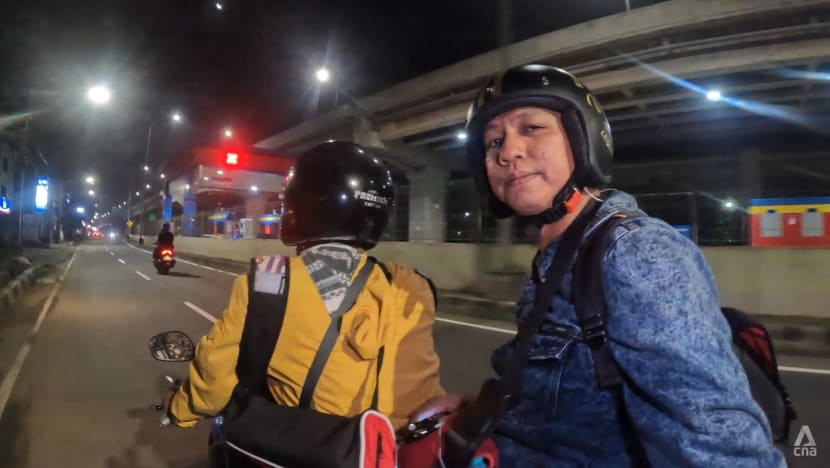
It would have taken a car three-and-a-half hours to complete the journey. But since it is illegal for motorcycles to use toll roads in Indonesia, our trip was limited to small country roads, prolonging our journey considerably.
We hit the road very early in the morning - 3am to be exact - to avoid as much traffic as we can.
Even so, the roads connecting the two cities were already filled with motorcyclists looking to perform mudik, identifiable by the amount of belongings they carry with them.
Some had backpacks slung over their shoulders. Others strapped duffle bags, even suitcases onto the seats of their motorcycles. There are also those who carried cardboard boxes, placed at the base of their scooters and sandwiched between their legs.
“We are urging motorcyclists not to carry too many items with them because it will make maneuvering difficult,” chief of the Indonesian Traffic Police Corps, Firman Santyabudi told CNA.
Wisnu and I quickly learned how important it is for motorcyclists to remain agile and alert on the road, particularly as fatigue sets in.
Two hours into our trip, we saw two motorcycles skidding on a slippery, potholed road despite carrying few belongings with them. The riders were largely unharmed although one motorcycle had its handlebar bent and was unlikely to continue its journey without a visit to the repair shop.
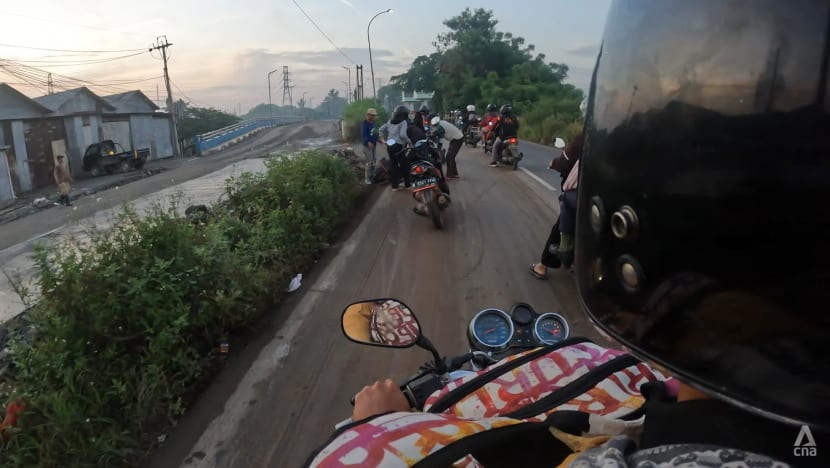
Minutes later, just when the sun was about to rise, we were hit from the rear by a motorcyclist as we stopped at a traffic light. The motorcyclist told us he was sleepy and lost focus for a split second.
The collision - as loud and startling as it was to Wisnu and I - resulted in a few scratches and mild damages to our motorcycle’s license plate and rear left blinker. But I could feel the man’s front wheel grazing my heel.
The man asked for our forgiveness and we decided to let go of the incident on the promise that he would find some place to rest.
We soon hit the road again, this time with a reminder that being on the road can be unpredictable and dangerous.
JOURNEY UNSAFE AND UNCOMFORTABLE
As we entered our fourth hour on the road, fatigue began to set in and I struggled to stay awake.
I requested that we find a place to rest but the only place safe and decent enough for us to sleep was on the concrete floor in front of an empty store.
The floor was dusty and hard but we slept for about 30 minutes, making a pillow out of our backpacks and using our jackets to shade us from the blazing sun.
“This is what us motorcyclists have to deal with,” my visual journalist, Wisnu said.
He added that as Idul Fitri draws near and the roads become more crowded with mudik-goers, it is easy to find people sleeping at mosques, store fronts, gas stations and even pavements.
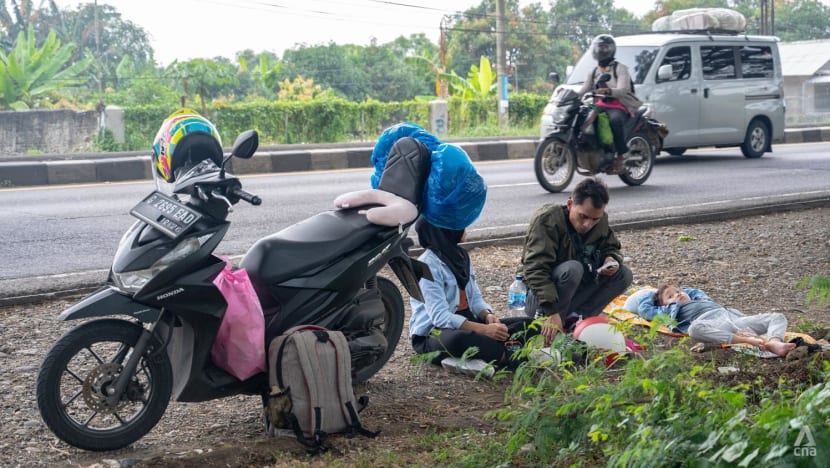
It is a stark contrast to the comfort and convenience enjoyed by those on four wheels. Had we chosen to drive a car, we could have easily parked at the many rest stops dotting the toll roads, reclined our seats and turned on the air-conditioner.
We would also be less worried about getting our motorcycle or belongings stolen, particularly on quiet and remote provincial roads.
I woke up from my nap drenched in sweat. My sleepiness was behind me but not my fatigue. I remained glued to the concrete floor for another 20 minutes, watching motorcyclists past the dusty, winding road.
It was easy to spot families of four, sometimes five on a single motorcycle. Occasionally, there were toddlers sleeping on their respective mothers’ arms. Very few of these children were seen wearing a helmet.
Djoko Setijowarno, a transportation expert from Soegijapranata Catholic University said riding a motorcycle can be far cheaper than other forms of transportation.
For poorer families who might struggle to buy tickets for trains and buses, prices of which can skyrocket during the mudik season, motorcycle is the only way to perform mudik to return to their hometowns.
“For some, (affordability) is more important than safety,” he told CNA. “We need to take this seriously. At the very least, the government should ban children. Don’t let (motorcyclists) bring their children (on a mudik journey).”
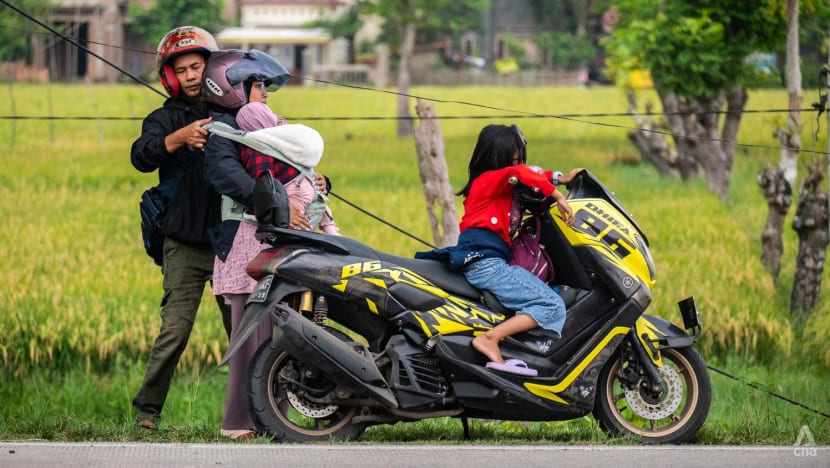
Although aware that some of these motorcyclists are breaking the law, traffic police chief Santyabudi said the 92,000 police officers deployed across the country to safeguard mudik will focus more on providing warnings to violators instead of taking legal action.
“This operation is about humanity that focuses on public service. We don’t want to be perceived as people who will give out tickets. We don’t want to be the one who limits people’s desire to go home. We are there to assist people to make sure their journey is safe, secure and comfortable,” he said.
EFFORTS IN PLACE TO DISSUADE THE PRACTICE
Various government institutions have tried to dissuade people from performing mudik on motorcycles.
The Transport Ministry, for instance, is handing out free tickets to 10,000 passengers and space for 5,000 motorcycles on board ferries connecting Jakarta and the Central Javan city of Semarang. The two cities are 470km apart.
The ministry is also providing railroad cars which can carry up to 10,000 motorcycles to various cities across Indonesia. The programme is not free, however, although passengers only need to buy tickets for themselves and not for their motorcycles.
Meanwhile, the Jakarta City government is providing three trucks capable of transporting a total of 80 motorcycles from the Indonesian capital to Solo, Central Java, some 560km away, while their passengers hop on free buses provided by the city.
Transportation expert Setijowarno said these efforts are only temporary fixes which can only accommodate a small fraction of mudik-goers since they are limited both in terms of quota and destination.
The government, he said, should instead focus on improving public transportation in cities across Indonesia.
“Public transportation in smaller cities and towns is not as good as Jakarta, which is why some people bring their motorcycles with them if they want to get around in their hometowns,” he said.
Muhammad Rudy, one of the motorcyclists we met on the road, echoed the transport expert’s sentiment.
“That is why my wife and kids are travelling by bus and I travel by motorcycle,” the 34-year-old told CNA on his way to Batang, Central Java, located some 370km from Jakarta.
Another traveller, Ahmad Fuady, 32, said he chose to take his wife and child on a motorcycle because his hometown is only 132km away from Jakarta in West Java’s Subang Regency. His hometown, he said, is not served by either train or buses.
“The government should at least make it safer and more comfortable for those performing mudik on a motorcycle. Those who travel by car have access to toll roads with smooth road surfaces and rest areas. Whereas for us - we motorcyclists have to deal with potholed roads with very little illumination (from street lights),” he told CNA.
Indeed, the journey from Jakarta to Cirebon is filled with roads which were not well maintained. There were also no dedicated places where motorcyclists can safely and comfortably rest during their journey aside from restaurants, mosques and petrol stations.
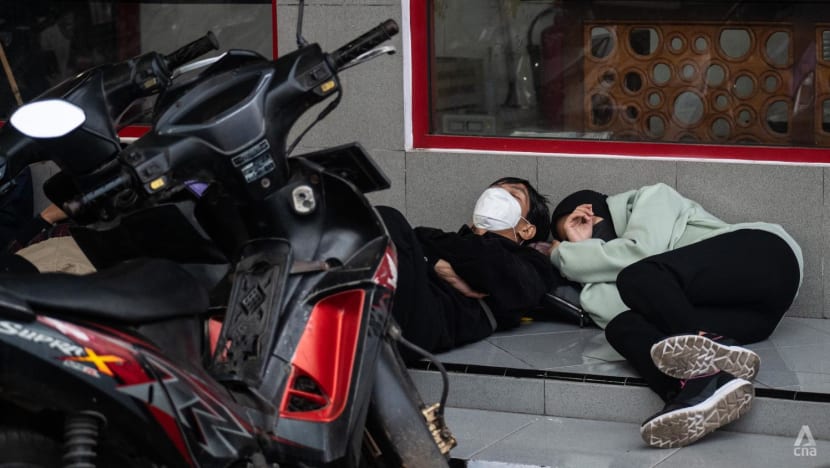
We had spent more than 10 hours on the road, stopping here and there to stretch our legs, eat and rest. I was exhausted, sleep-deprived, my body was in pain but I was relieved and overjoyed that my ride was finally over.
But the journey is far from over for some of these motorcyclists.
They are still hundreds of kilometres away from their hometowns where they will spend the next few days with their families and childhood friends.
And pretty soon, they will have to hit the road again, this time going the opposite direction: Back to where they live and work in major cities like Jakarta.
















